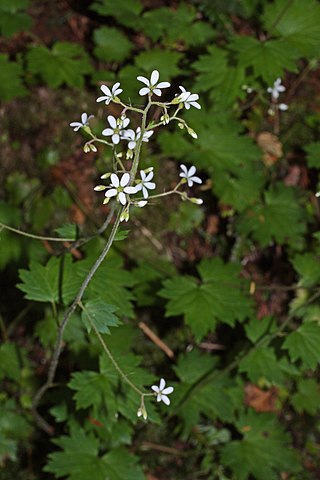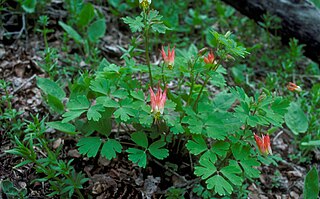
Thunbergia alata, commonly called black-eyed Susan vine, is a herbaceous perennial climbing plant species in the family Acanthaceae. It is native to Eastern Africa, and has been naturalized in other parts of the world.

Ammannia gracilis is a species of flowering plant in the family Lythraceae. It is native to Africa.

Erysimum cheiri, syn. Cheiranthus cheiri, the wallflower, is a species of flowering plant in the family Brassicaceae (Cruciferae), native to Greece, but widespread as an introduced species elsewhere. It is also treated as a hybrid under the name Erysimum × cheiri. It is widely cultivated as a garden plant.
Erysimum teretifolium is a species of Erysimum known by the common names Santa Cruz wallflower and Ben Lomond wallflower. It is a very rare plant endemic to Santa Cruz County, California, where it grows on inland sand spits, chaparral, and sandstone deposits in the southern Santa Cruz Mountains. It is a California state and federally listed endangered species.

Juncus confusus is a species of rush known by the common name Colorado rush. It is native to western North America from British Columbia to northern California to Colorado, where it grows in coniferous forests and wet, grassy areas such as mountain meadows. It is a bunching rhizomatous perennial herb which grows to a maximum height between 30 and 50 centimeters. Its thready leaves grow from the base of the light green stems to about 15 centimeters long. The inflorescence atop the stem is an array of individual flowers and there is a long bract at the base which may be up to 8 centimeters in length. Each flower has long, pointed tepals with dark and light longitudinal stripes and membranous, translucent borders. There are six stamens. The fruit is a light to dark brown oval-shaped or rounded capsule.

Atriplex leucophylla is a species of saltbush known by the common names beach saltbush and white orache. It is native to the coastline of California and Baja California, and the Channel Islands, where it is a resident of beach dunes and other sandy areas.

Lepidium flavum is a species of flowering plant in the mustard family known by the common name yellow pepperweed. It is native to California, Nevada, and Baja California, where it grows in the Sonoran and Mojave Deserts. The species epithet flavum is Latin for yellow and indicates its flower colour.

Allium praecox is a species of wild onion known by the common name early onion.

Ammannia robusta is a species of flowering plant in the loosestrife family known by the common name grand redstem. It is widespread across much of North America with additional populations in southeastern Brazil.

Boykinia occidentalis is a species of flowering plant in the saxifrage family known by the common name coastal brookfoam. It is native to the west coast of North America from British Columbia to California, where it grows in shady areas near riverbanks and streams. It is a rhizomatous perennial herb producing large, rounded leaves with blades up to 45 centimeters long and 12 wide, borne on petioles up to 30 centimeters in length. Each leaf has several rounded lobes with dull teeth along the edges. The inflorescence reaches 30 to 60 centimeters tall on a thin stem. It bears an open array of many small white flowers, each with five tiny pointed sepals and five larger oval petals.
Collinsia corymbosa is a species of flowering plant in the plantain family known by the common name round-headed Chinese houses. It is endemic to the coastline of California north of the San Francisco Bay Area, where it is uncommon and scattered. Its habitat is the sand dunes of the immediate coastline. This is an annual herb producing a scaly, hairy, red to reddish green stem which grows upright or decumbent to a maximum length of about 25 centimeters. The thick, sparsely hairy leaves are rippled and lobed along the edges, which may be somewhat turned under. The inflorescence is a dense whorl of several distinctive flowers. Each has a hairy calyx of lobed reddish sepals and a corolla up to about 2 centimeters long. The flower has two small upper lobes and three longer lower lobes which come together in a nearly tubular shape. It is generally white with a light purple tint. The smaller upper lobes curl back and dry to brown at their lips.

Hoita strobilina is a rare species of legume known by the common name Loma Prieta leatherroot, or Loma Prieta hoita. It is endemic to California, where it is known from occasional occurrences in the San Francisco Bay Area. It grows in chaparral and woodland habitat in the local mountains, often on serpentine soil. This is a perennial herb growing erect, approaching a meter in maximum height. The large leaves are divided into three leaflets each up to 8 centimeters long and lance-shaped to nearly round. The herbage is generally glandular and hairy. The inflorescence is a raceme up to 13 centimeters long containing many pealike flowers. Each flower is purple, sometimes with white parts, and one to two centimeters long. The fruit is a dark brown or black, hairy, veiny legume pod.
Boechera dispar is a species of flowering plant in the family Brassicaceae known by the common name pinyon rockcress. It is native to eastern California and western Nevada, where it grows in rocky areas in desert and mountain habitat. This is a perennial herb growing from a branching caudex. It produces several erect stems reaching 10 to 25 centimeters tall. The leaves are mostly located about the caudex. They are linear to lance-shaped, coated in white hairs, and one or two centimeters long. The flowers have purple petals. The fruit is a long, narrow, hairless silique up to 7 centimeters long containing round, winged seeds.
Mentzelia reflexa is a species of flowering plant in the family Loasaceae known by the common name reflexed blazingstar.

Porterella is a monotypic genus of flowering plants in the bellflower family containing the single species Porterella carnosula, which is known by the common name fleshy porterella, or simply porterella.
Romanzoffia tracyi is a species of flowering plant in the borage family known by the common names Tracy's mistmaiden and Tracy's romanzoffia. It is native to the coastline of western North America from far northern California north to the southern tip of Vancouver Island, where it grows among rocks on oceanside bluffs.

Aquilegia elegantula is a species of columbine known by the common name western red columbine. It is native to the southwestern United States, particularly the Four Corners states, and northern Mexico, where it grows in moist areas in mountain coniferous forests. It is a rhizomatous perennial herb growing 10 t 60 centimeters tall. The green leaf blades are borne on long, slender petioles and divided into three leaflets which each have rounded lobes along the front edges. The flower has five long petals up to 3 centimeters in length including their elongated, knob-tipped spurs. The petals are bright red in the spurs and lighten to yellow-green or orange at the tips. Between the petals are the oval-shaped sepals, which are reddish to yellowish in color and are held parallel to the petals. Flowers often droop such that the mouth is toward the ground and the spurs point up; the flowers are pollinated by the broad-tailed hummingbird.
Mentzelia packardiae is a species of flowering plant in the Loasaceae known by the common names Packard's blazingstar and Packard's stickleaf. It is native to the western United States, where it is known from a small area in Oregon and Nevada.

Ammannia baccifera, also known as the monarch redstem or blistering ammannia is a species in the family Lythraceae. It is widespread in the tropical regions of Asia, America and Africa. It has been naturalized in Spain. It is annual and herbaceous, and can be found in marshes, swamps, rice fields and water courses at low elevations. It is considered endangered in Israel, but because it is widespread and common elsewhere, the IUCN considers it to be 'Least Concern'. The plant Ammannia baccifera Linn. is erect, branched, smooth, slender, annual, more or less purplish herb 10 to 50 centimeters in height. The stems are somewhat 4-angled. The leaves are oblong, oblanceolate, or narrowly elliptic, about 3.5 centimeters long – those on the branches very numerous, small, and 1 to 1.5 centimeters long – with narrowed base and pointed or somewhat rounded tip. The flowers are small, about 1.2 millimeters long, greenish or purplish, and borne in dense axillary clusters. The capsules are nearly spherical, depressed, about 1.2 millimeters in diameter, purple, and irregularly circumscribes above the middle. The seeds are black.

Ammannia auriculata, commonly known as eared redstem, is a species in the family Lythraceae that is found in tropical and subtropicalt areas around much of the world.














